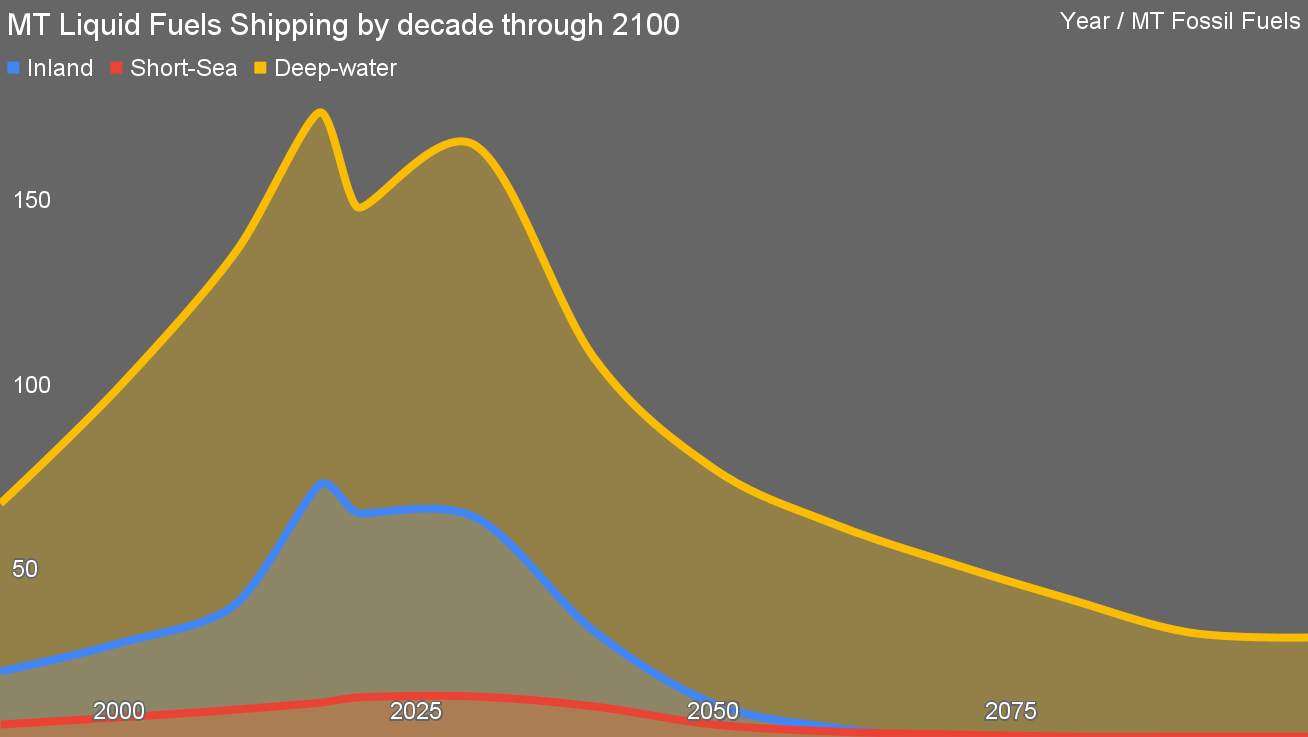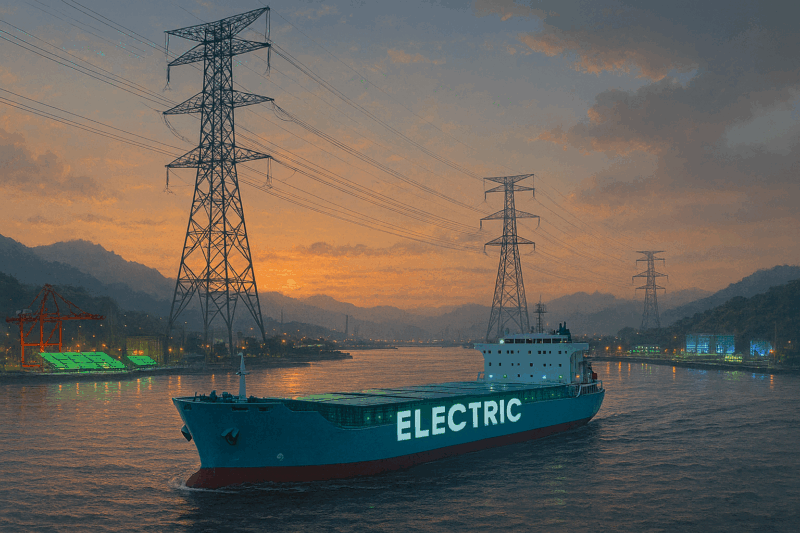Support CleanTechnica’s work through a Substack subscription or on Stripe.
The Gezhouba, a new 13,000-ton all-electric bulk carrier launched in Yichang, is more than a technical milestone. It is a sign that the electrification of inland shipping is moving from concept to inevitability. The vessel’s 24 MWh of containerized lithium battery modules can move cargo roughly 500 km on a single charge per the launch announcement, and its home port already hosts the first dedicated charging station on the Yangtze River. For years, analysts have speculated that the physical scale of bulk carriers would make batteries impractical. Now the question is no longer whether electric bulk transport can work, but how quickly the infrastructure will spread to support it.
Port electrification follows a predictable sequence. The first stage replaces diesel cranes, trucks, and yard equipment with electric systems. The second extends to tugs and harbor craft. The third, which is now underway in China, reaches inland and short-sea vessels. The fourth will see ports functioning as full energy hubs, feeding deep-sea hybrids and stabilizing regional grids. Every stage builds on the one before it. Once the ground vehicles and cranes switch to electric drive, high-capacity chargers and energy management systems are already in place. Those same assets can serve harbor craft and ships. Electrification propagates by infrastructure reuse.
The Yangtze River has become a living demonstration of this process. It connects the interior manufacturing centers of Chongqing, Wuhan, and Yichang with the export hubs of Shanghai, Nanjing, and Ningbo. Along its length, the physical river has been matched by a set of electrical arteries. Two of them, the Changji–Guquan and Hami–Chongqing UHVDC transmission lines, deliver more than 30 TWh of renewable power each year from the deserts and plateaus of the west to the dense industrial east. Together they provide up to 8 GW of clean capacity directly into the Yangtze corridor. These ultra-high-voltage direct current lines are the spine of a new energy geography, making clean electrons available where cargo and industry already cluster. Without that grid backbone, even the most efficient electric ship would be an isolated experiment.
Yichang, where the Gezhouba was built, has become one of the first inland ports to integrate ship charging into its grid operations. The facility’s 800 kVA shore connection powers both stationary equipment and vessels. A smaller network of similar stations now stretches along mid-river ports handling bulk materials like ore and aggregates. Farther east, the delta ports are evolving faster still. Shanghai, Jiangsu, and Zhejiang are co-locating offshore wind with platform-based offshore solar and large battery banks. Jiangsu’s Rudong complex pairs 400 MW of offshore PV with grid-scale storage. Ningbo and Zhoushan have already replaced diesel power for cranes and heavy cargo gear, reporting tens of GWh of electric energy delivered to port operations each year. These changes make the delta ports partial power plants, capable of feeding ships, vehicles, and local industry from the same renewable base.
The Gezhouba itself is built around twelve modular battery units packaged in steel boxes roughly the size of shipping containers. Each contains immersion-cooled lithium cells suspended in silicone oil for safety and temperature control. The modules can be charged in place or swapped out entirely at a port. This approach mirrors the 700-TEU Yangtze container ships already in service that exchange standardized battery containers at dedicated swap stations. Standardization matters because it allows operators to share infrastructure, spreading costs across multiple fleets and shortening turnaround times. In design and operation, the new bulk carrier follows the same logic that has already worked for smaller container ships and ferries. Predictable routes, steady loads, and controlled terminals make electric propulsion an economic choice rather than a demonstration.
Bulk carriers are often considered poor candidates for electrification because of their energy intensity, but inland routes have different constraints than ocean crossings. River vessels spend much of their time at low speeds, stop frequently, and operate between fixed terminals. Those characteristics make energy demand manageable and allow recharging or battery exchange to fit naturally into loading cycles. The Gezhouba’s route between Yichang and downstream industrial zones is exactly the kind of steady corridor where battery freight makes sense. Its performance data will shape the specifications for the next generation of inland bulk carriers, which will likely standardize on containerized modules, automated docking, and shared charging infrastructure.
There are still gaps to close. The battery modules must be standardized across manufacturers, with compatible cooling, interlocks, and communication systems. The supply chain for lithium cells, power electronics, and large converters must expand to support a fleet rather than a prototype. Smaller river ports need grid reinforcements and on-site storage to handle charging peaks. These are not technical barriers but sequencing problems. Each requires coordination between shipbuilders, utilities, and port authorities, not new physics. In that sense, the challenges resemble the early years of electric trucking and aviation, where infrastructure growth followed successful pilot routes rather than preceding them.

Viewed in the larger context of maritime energy, the Yangtze experiment sits within a clear global trend. Inland and short-sea shipping will electrify almost completely by mid-century, while deep-sea vessels transition more slowly through hybrid designs. Battery density and cost curves already favor routes under 1,000 km. As ultra-high-voltage transmission and local renewable capacity expand, the line between port infrastructure and power generation blurs. Ports are becoming nodes in a continental electrical system. They no longer only move cargo but balance supply and demand for regional grids.
This is against a backdrop of radical change in shipping volumes. 40% of all tonnage is of fossil fuels and all are in structural decline. Another 15% is raw iron ore, also in structure decline. Population growth is slowing and the global population is expected to peak between 2050 and 2070. While container shipping will continue to grow, it won’t be growing nearly as fast as bulks decline.
What is happening along the Yangtze suggests how this will evolve elsewhere. Europe’s Rhine corridor, North America’s Mississippi system, and Southeast Asia’s Mekong delta all have the same combination of dense trade, predictable routes, and nearby renewable resources. Once reliable electric power reaches the terminals, electrification of the vessels themselves follows almost automatically. The Gezhouba is not an outlier but an early arrival.

The end state is easy to describe even if it will take decades to reach. Ports will act as energy hubs that receive renewable electricity through long-distance HVDC lines and distribute it through local solar, storage, and charging systems. Every vehicle, crane, and ship in the port ecosystem will run on electricity. Some ports will also feed power back to the grid during high demand periods. Inland shipping will be entirely electric, coastal routes mostly so, and only transoceanic freight will depend on hybrid systems with combustion as backup. The river that once carried coal and oil will carry the power that replaces them.
No one can claim to be entirely right about the pace or order of these transitions. I do claim to be less wrong than many. Energy systems evolve through trials and feedback, not linear plans. But it is becoming clear which directions are durable. The Gezhouba’s quiet launch on the Yangtze is a reminder that once the electricity is clean and the grid is strong, moving freight by battery is not just possible. It is the default waiting to be recognized.
Sign up for CleanTechnica’s Weekly Substack for Zach and Scott’s in-depth analyses and high level summaries, sign up for our daily newsletter, and follow us on Google News!
Have a tip for CleanTechnica? Want to advertise? Want to suggest a guest for our CleanTech Talk podcast? Contact us here.
Sign up for our daily newsletter for 15 new cleantech stories a day. Or sign up for our weekly one on top stories of the week if daily is too frequent.
CleanTechnica uses affiliate links. See our policy here.
CleanTechnica’s Comment Policy


